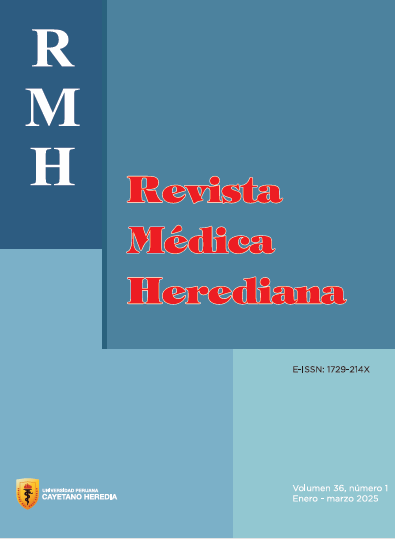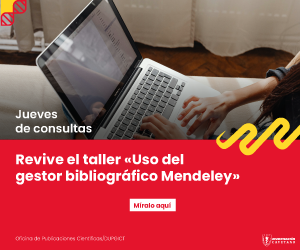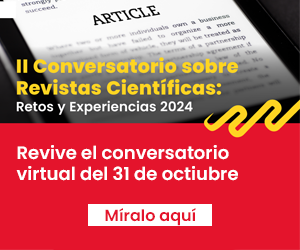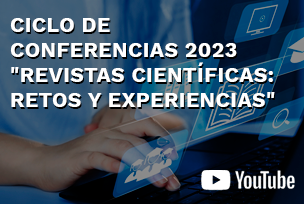"Need, Design, and Development of Educational Software for Basic Ophthalmology Learning in Medical Students"
DOI:
https://doi.org/10.20453/rmh.v36i2.5684Keywords:
Information Technology, interactive tutorial, multimedia, software, medical educationAbstract
The importance of adopting information and communication technologies in medical education is highlighted, as is the need to develop educational software (ES) to teach basic ophthalmology to medical students. Objectives: To determine the need to develop ES for learning basic ophthalmology and to design and develop the educational software. Methods: An operational research study was conducted in three stages: needs assessment, design, and development of the ES. A bibliographic search was conducted in the MEDLINE/PubMed, Scopus, and LILACS databases, and the ophthalmology curricula for medical students from four Peruvian universities were reviewed. Following this, the design method was explained and justified. Results: It was found that, worldwide, there are limited and isolated experiences with ES related to ophthalmology teaching, and no reported experiences in Peru. The time allocated for learning ophthalmology in the curricula averaged two theoretical class sessions, three clinical practice sessions, and one laboratory session. The ES was well justified and detailed, based on its thematic content and presentation format. Conclusions: The need for the designed ES with ophthalmology content for undergraduate medical education was identified. The development of ophthalmology ES aimed at medical students is essential as a didactic educational support resource.
Downloads
References
Prieto MSF. La aplicación de las nuevas tecnologías en la educación. Tendencias Pedag. 2001; 6:139-48. Disponible en: https://revistas.uam.es/tendenciaspedagogicas/article/view/1811
Ortiz G. Cómputo y Educación: Panorámica. Sinéctica. 1993 jul-dic [citado 10 de abril de 2025]; 3:1-6. Disponible en: https://www.redalyc.org/articulo.oa?id=99825983007
Pérez-Martinot M. Uso actual de las tecnologías de información y comunicación en la educación médica. Rev Med Hered. 21 de diciembre de 2017; 28:258-265. doi: 10.20453/rmh.v28i4.3227. Disponible en: https://revistas.upch.edu.pe/index.php/RMH/article/view/3227
Fernández Vásquez JA, Cadillo F, Pérez M. G, Cruz B. A, Menjívar A, Laínez V, et al. Análisis de los problemas en la enseñanza de la semiología médica en la Facultad de Ciencias Médicas de Universidad Nacional Autónoma de Honduras (a). Rev Med Hondur. 1995; 63(2):52-6. Disponible en: https://pesquisa.bvsalud.org/portal/resource/pt/lil-224629
Abdul-Kadir MA, Lim LT. Enriching traditional didactic teaching in undergraduate ophthalmology with lateral thinking method: a prospective study. BMC Med Educ. 17 de mayo de 2022;22(1):379. doi: 10.1186/s12909-022-03443-2.
Devitt P, Smith JR, Palmer E. Improved student learning in ophthalmology with computer-aided instruction. Eye (Lond). 2001 Oct;15(Pt 5):635-9. doi: 10.1038/eye.2001.199.
Succar T, Zebington G, Billson F, Byth K, Barrie S, McCluskey P, et al. The impact of the Virtual Ophthalmology Clinic on medical students’ learning: a randomised controlled trial. Eye (Lond). 2013 Oct;27(10):1151-7. doi: 10.1038/eye.2013.143.
Ministerio de Salud. Plan de la Estrategia Sanitaria Nacional. Salud Ocular y Prevención de la Ceguera: 2014-2020 [Internet]. MINSA; 2014 [citado 31 de marzo de 2023]. Disponible en: https://bibliotecavirtual.insnsb.gob.pe/plan-de-la-estrategia-sanitaria-nacional-salud-ocular-y-prevencion-de-la-ceguera-2014-2020/
Pérez-Martinot M. Software educativo como medio de apoyo para el aprendizaje de oftalmología básica para estudiantes de medicina [tesis Doctor en Medicina]. Perú: Universidad Peruana Cayetano Heredia, Facultad de Medicina; 2023. [Citado el 31 de marzo 2023]. Disponible en: https://repositorio.upch.edu.pe/bitstream/handle/20.500.12866/14687/Software_PerezMartinot_Manuel.pdf?sequence=1
Naidoo P. Investigación operativa para mejorar los servicios de salud [Internet]. Centro desmond Tutu contra la tuberculosis; 2013. [Citado el 31 de marzo de 2023]. Disponible en: https://theunion.org/sites/default/files/2020-08/2013-Operational-Researchto-Improve-Health-Services_Spanish-1.pdf
Leguizamon M. Diseño y desarrollo de materiales educativos computarizados (mec): Una posibilidad para integrar la informática con las demás áreas del currículo. Rev virtual univ catol norte. 2006 [Citado el 31 de marzo de 2023]; 1(19). Disponible en: https://revistavirtual.ucn.edu.co/index.php/RevistaUCN/article/view/190
Galvis Panqueva A, Castro R, Marino O. Ingeniería de software educativo con modelaje orientado a objetos. Un medio para desarrollar micro-mundos interactivos. Inf Educ. 1 de enero de 1998 [Citado el 31de marzo de 2023];11(1):9-30. Disponible en: https://repositorioutlvte.org/Repositorio/2024-01-08-FQSA-01607.pdf
Zvornicanin E, Zvornicanin J, Hadziefendic B. The Use of Smartphones in Ophthalmology. Acta Inform Med. 2014 Jun;22(3):206-9. doi: 10.5455/aim.2014.22.206-209.
Dunn HP, Kang CJ, Marks S, Witherow JL, Dunn SM, Healey PR, et al. Perceived usefulness and ease of use of fundoscopy by medical students: a randomised crossover trial of six technologies (eFOCUS 1). BMC Med Educ. 8 de enero de 2021;21(1):41. doi: 10.1186/s12909-020-02469-8.
Kelly LP, Garza PS, Bruce BB, Graubart EB, Newman NJ, Biousse V. Teaching ophthalmoscopy to medical students (the TOTeMS study). Am J Ophthalmol. noviembre de 2013;156(5):1056-1061.e10. doi: 10.1016/j.ajo.2013.06.022.
Shikino K, Suzuki S, Hirota Y, Kikukawa M, Ikusaka M. Effect of the iExaminer Teaching Method on Fundus Examination Skills: A Randomized Clinical Trial. JAMA Netw Open. 4 de septiembre de 2019;2(9):e1911891. doi: 10.1001/jamanetworkopen.2019.11891.
Medina DL. Software educativo: Morfofisiología del ojo humano. Rev Cienc Méd. 2014 [Citado el 31 de marzo de 2023];18(5):878-92. Disponible en: http://scielo.sld.cu/scielo.php?script=sci_arttext&pid=S1561-31942014000500016&lng=es.
Petrarca CA, Warner J, Simpson A, Petrarca R, Douiri A, Byrne D, et al. Evaluation of eLearning for the teaching of undergraduate ophthalmology at medical school: a randomised controlled crossover study. Eye (Lond). 2018 Sep;32(9):1498-1503. doi: 10.1038/s41433-018-0096-1.
Bergqvist J, Person A, Vestergaard A, Grauslund J. Establishment of a validated training programme on the Eyesi cataract simulator. A prospective randomized study. Acta Ophthalmol. noviembre de 2014;92(7):629-34. doi: 10.1111/aos.12383.
Cissé C, Angioi K, Luc A, Berrod JP, Conart JB. EYESI surgical simulator: validity evidence of the vitreoretinal modules. Acta Ophthalmol. marzo de 2019;97(2):e277-82. doi: 10.1111/aos.13910. Disponible en: https://onlinelibrary.wiley.com/doi/abs/10.1111/aos.13910
Succar T, Zebington G, Billson F, Byth K, Barrie S, McCluskey P, et al. The impact of the Virtual Ophthalmology Clinic on medical students’ learning: a randomised controlled trial. Eye Lond Engl. octubre de 2013;27(10):1151-7. doi: 10.1038/eye.2013.143
Peña J, Corredor M, Orozco L, Serrano M. Evaluación de un material educativo informatizado como herramienta para el aprendizaje del examen cardiovascular. Inf Educ. 1999; 12:111-23.
Ramírez LPR, Tamayo ÓET. Aprendizaje profundo en semiología neurológica mediante una herramienta informática. Hacia Promoc Salud. 23 de diciembre de 2011;16(2):109-20. Disponible en: https://revistasojs.ucaldas.edu.co/index.php/hacialapromociondelasalud/article/view/1910
Torales Chaparro OE. Diseño y evaluación de una aplicación multimedia para la enseñanza de radiología a alumnos de medicina (ameram) [Internet] [Tesis doctoral]. Universidad de Málaga; 2009 [citado 16 de octubre de 2023]. Disponible en: https://dialnet.unirioja.es/servlet/tesis?codigo=285054
Sim D, Hussain A, Tebbal A, Daly S, Pringle E, Ionides A. National survey of the management of eye emergencies in the accident and emergency departments by senior house officers: 10 years on - Has anything changed? Emerg Med J. 2008 Mar;25:76-7. doi: 10.1136/emj.2007.049999.
Galvis-Panqueva AH. Software Educativo Multimedia. Rev Bras Informática Na Educ. 1997;1(1):9-18. Disponible en: http://ojs.sector3.com.br/index.php/rbie/article/view/2319
Braude EJ. Ingeniería de software: una perspectiva orientada a objetos. México: Alfaomega. 2003. 539 p.
García E, Vite O, Navarrate MÁ, García MÁ, Torres V. Metodología para el desarrollo de software multimedia educativo MEDESME. CPU-E Rev Investig Educ [Internet]. 6 de julio de 2016 [citado 31 de marzo de 2023];(23):216-26. Disponible en: http://cpue.uv.mx/index.php/cpue/article/view/2169
Åsman P, Lindén C. Internet-based assessment of medical students’ ophthalmoscopy skills. Acta Ophthalmol (Copenh) [Internet]. 2010 [citado 25 de julio de 2023];88(8):854-7. Disponible en: https://onlinelibrary.wiley.com/doi/abs/10.1111/j.1755-3768.2009.01601.x
Bandhu SD, Raje S. Experiences with E-learning in Ophthalmology. Indian J Ophthalmol [Internet]. 2014;62(7):792-4. Disponible en: https://www.ncbi.nlm.nih.gov/pmc/articles/PMC4152649/
Dean WH, Buchan J, Gichuhi S, Philippin H, Arunga S, Mukome A, et al. Simulation-based surgical education for glaucoma versus conventional training alone: the GLAucoma Simulated Surgery (GLASS) trial. A multicentre, multicountry, randomised controlled, investigator-masked educational intervention efficacy trial in Kenya. Br J Ophthalmol. 2022;106(6):863-9.
Dean WH, Gichuhi S, Buchan JC, Makupa W, Mukome A, Otiti-Sengeri J, et al. Intense Simulation-Based Surgical Education for Manual Small-Incision Cataract Surgery: The Ophthalmic Learning and Improvement Initiative in Cataract Surgery Randomized Clinical Trial in Kenya, Tanzania, Uganda, and Zimbabwe. JAMA Ophthalmol. 2021;139(1):9-15.
Glittenberg C, Binder S. Using 3D computer simulations to enhance ophthalmic training. Ophthalmic Physiol Opt [Internet]. 2006 [citado 25 de julio de 2023];26(1):40-9. Disponible en: https://onlinelibrary.wiley.com/doi/abs/10.1111/j.1475-1313.2005.00358.x
Ricci L, Ferraz C. Ophthalmoscopy simulation: advances in training and practice for medical students and young ophthalmologists. Adv Med Educ Pract [Internet]. junio de 2017 [citado 15 de octubre de 2023]; 8:435-9. Disponible en: https://www.dovepress.com/ophthalmoscopy-simulation-advances-in-training-and-practice-for-medica-peer-reviewed-article-AMEP
Rose JS, Lalgudi S, Joshua RA, Paul J, Susanne MA, Phillips AC, et al. A validated audio-visual educational module on examination skills in ophthalmology for undergraduate medical students in the COVID-19 season - An observational longitudinal study. Indian J Ophthalmol [Internet]. 2021;69(2):400-5. Disponible en: https://www.ncbi.nlm.nih.gov/pmc/articles/PMC7933836/
Ting DSW, Sim SSKP, Yau CWL, Rosman M, Aw AT, Yeo IYS. Ophthalmology simulation for undergraduate and postgraduate clinical education. Int J Ophthalmol. 2016;9(6):920-4.
Wendt S, Abdullah Z, Barrett S, Daruwalla C, Go JA, Le B, et al. A virtual COVID-19 ophthalmology rotation. Surv Ophthalmol. abril de 2021;66(2):354-61.
Downloads
Published
How to Cite
Issue
Section
License
Copyright (c) 2025 Manuel Pérez-Martinot

This work is licensed under a Creative Commons Attribution 4.0 International License.
Authors assign their rights to the RMH so that may disseminate the article through the means at their disposal. The journal will provide forms of affidavit of authorship and authorization for the publication of the article, which shall be submitted with the manuscript. Authors retain the right to share, copy, distribute, perform and publicly communicate their article, or part of it, mentioning the original publication in the journal.




















